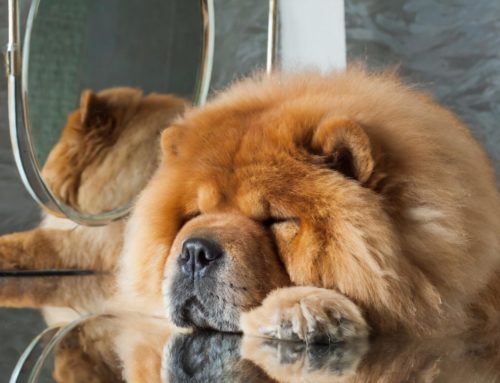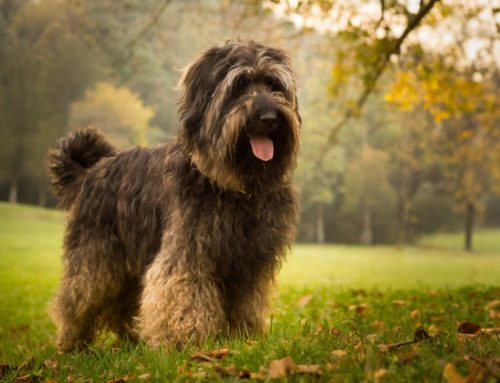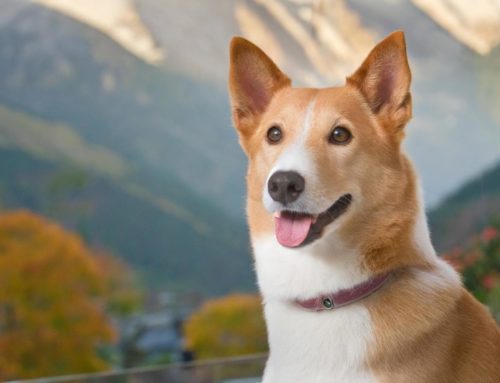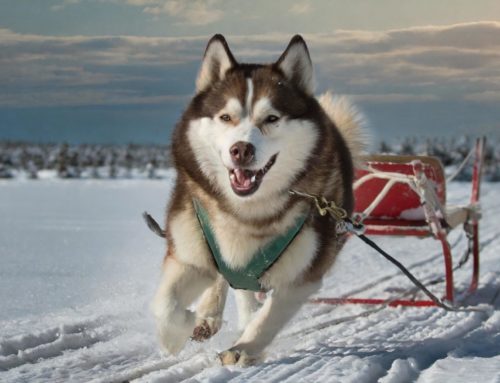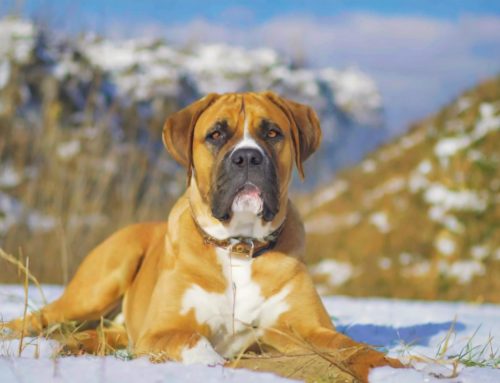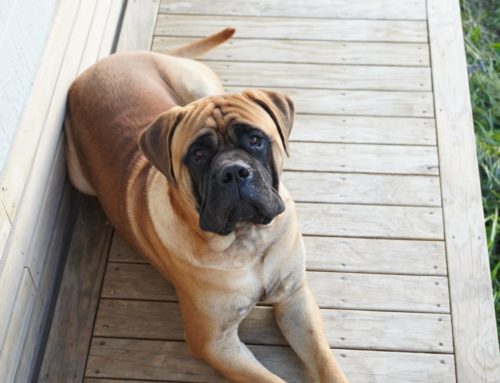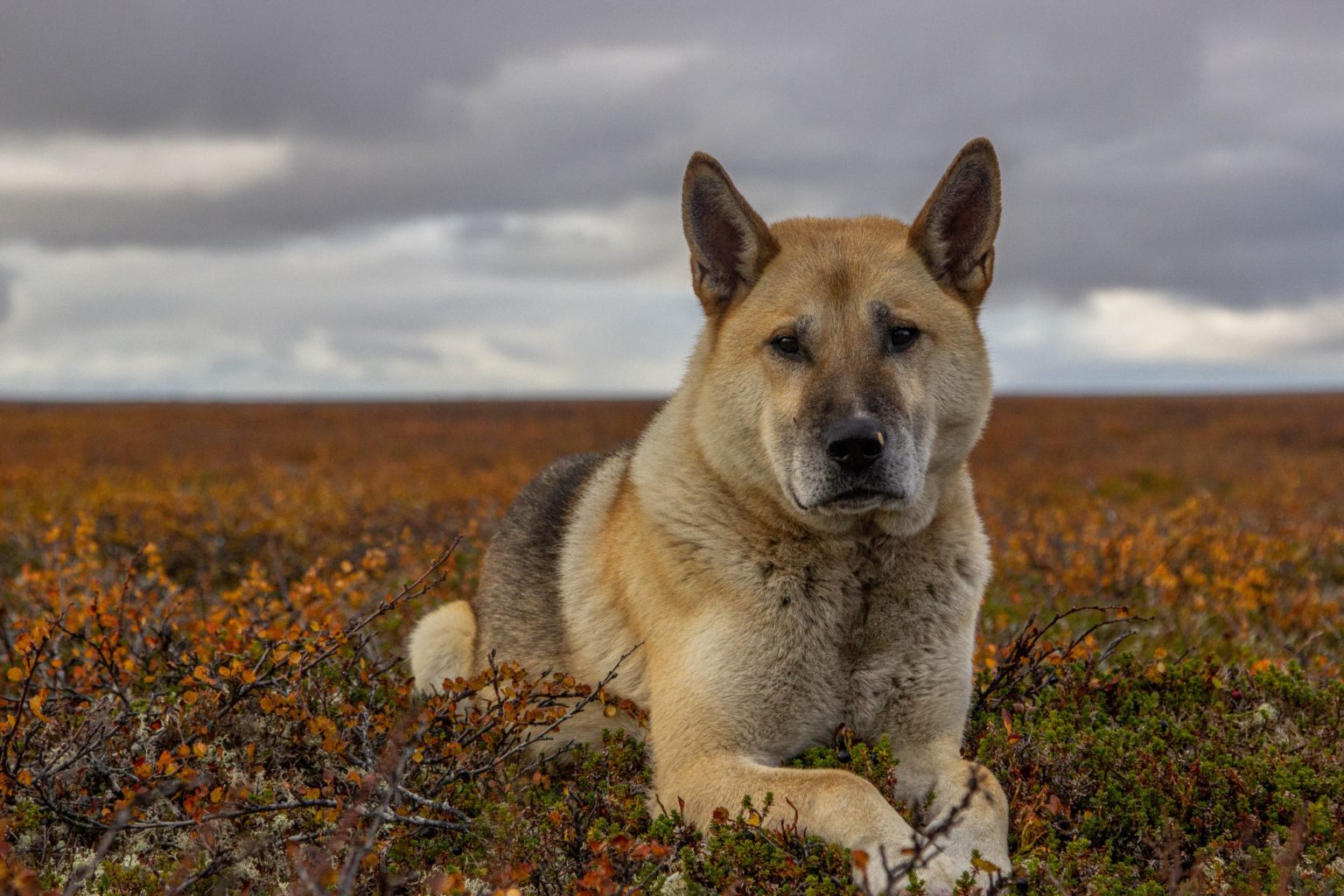
The American Akita, originally known as Great Japanese Dog, has a fascinating history originating in Japan. Originating from the Japanese Akita Inu, this dog breed was developed in the United States into the American variety we know today. American Akitas are distinguished by their strong and powerful build, fearless attitude and dominant nature.
In Japan, Akitas were originally bred for hunting instinct and guard dog tasks. When the breed was brought to America, its own breeding line emerged. American breeders in the United States selected and crossed these dogs, resulting in the larger and more robust American Akita.
The Fédération Cynologique Internationale (FCI) recognises the Japanese Akita Inu and the American Akita as two separate breeds, clearly distinguished by their physical characteristics and temperament.
The appearance of the American Akita
The American Akita, is an impressive and majestic breed of dog. The American Akita is a powerful, well-balanced dog with a strong and imposing stance. Characteristic are their erect ears and deep, broad muzzle that form a blunt triangle. The height at the withers of an American Akita can reach 71 cm and the weight can range up to about 59 kg, with a noticeable difference between males and females.
The Akita has a thick coat with a dense undercoat and a rougher outer coat that sheds twice a year, requiring intensive coat care. Coat colour can range from brindle (brindle) and spotted to uniform colours, including the distinctive white dogs, to colours such as sesame.
Hereditary diseases and disorders in the American Akita
The American Akita, a breed descended from the original Japanese Akita, is an intelligent and sensitive dog. Although the American Akita is very fond of its family and can be an excellent companion dog, there are some hereditary diseases and disorders to which the breed is susceptible.
The following is a list of common health problems:
- Hip dysplasia: A common problem in larger breeds, where the hip joint develops abnormally.
- Osteoarthritis: Degenerative joint disease, often resulting from hip dysplasia.
- Food intolerances: Some American Akitas can be sensitive to certain foods, requiring dietary management.
- Skin problems: Problems such as allergies and sebaceous gland disorders may occur, necessitating regular skin and coat care.
- Elbow dysplasia: Another joint disorder that can cause pain and restriction of movement.
- Thyroid disorders: Hypothyroidism can occur, which affects the dog’s metabolism.
- Autoimmune diseases: The breed may be prone to certain autoimmune diseases.
The character of the American Akita
The American Akita, a breed that originated from Japanese dogs but has evolved into a unique type, is known for its impressive character. An intelligent dog with a strong will of its own, the American Akita requires consistent and proper training from puppyhood.
Socialisation of an American Akita puppy is crucial; it helps them cope well with different situations, including dealing with children of the family and other pets.
These dogs are very fond of their human family and can develop into loyal and protective family members. Their archetypes as guard dogs are still prominent, making the American Akita an excellent guard dog.
They do not shy away from protecting their territory, but with proper socialisation and training, they can learn to distinguish between everyday situations and real threats.
Despite their eagerness to learn and intelligence, the American Akita is not the easiest breed to train. They have an independent nature and can sometimes be stubborn. Obedience training and sufficient mental and physical stimulation are essential.
These dogs need exercise and activity, and can perform well in various dog sports.
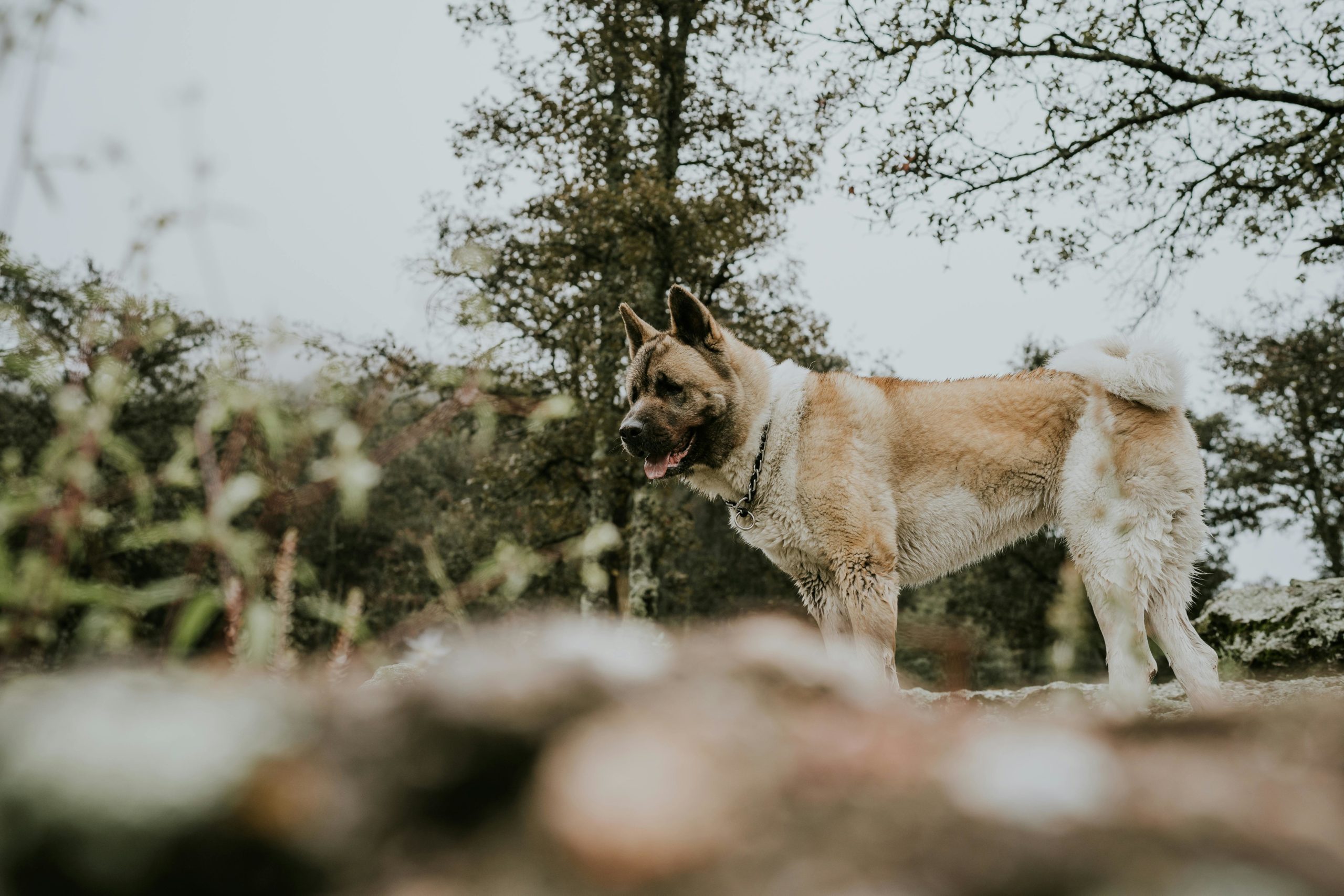
The Care of the American Akita
A purebred dog with a thick undercoat, the American Akita requires specific care and attention to stay healthy and happy. In 2023, as in previous years, breed associations stress the importance of proper grooming for these imposing dogs.
- Coat care: The American Akita’s double coat, with a thick undercoat and a hard outer coat, requires regular grooming. Especially during moulting, which usually occurs twice a year, frequent brushing is necessary to remove loose hairs and prevent the formation of tangles. This also helps minimise problems with sebum production.
- Nutrition and Health: The American Akita is prone to certain health problems, such as elbow joint disorders and food intolerances. A balanced diet tailored to their specific needs is essential. Consult a vet for advice on the best diet for your dog.
- Exercise: These dogs need plenty of exercise. Regular walks and playtime are essential to keep them physically and mentally stimulated. While running loose in a safe environment is good for their well-being, it is important to monitor their behaviour, especially if they are not well socialised
- Socialisation: The American Akita should be well socialised from puppyhood, especially if they are part of a family with children. This breed is very fond of its family, but can be reserved towards strangers and other animals. Consistent and positive socialisation helps promote desired behaviour.
Socialisation and upbringing of the American Akita
Socialisation and upbringing of the American Akita are crucial aspects of owning this impressive dog breed. Very fond of its human family, the American Akita requires a dedicated approach in both parenting and socialisation.
As strong and independent dogs, they require an owner who understands what behaviours they naturally exhibit and how to deal with them.
- Socialisation: It is important to socialise the American Akita from an early age, especially if they are part of a family with children. These dogs can learn to live well with children, but need to learn early what is acceptable behaviour. This also applies to other pets; although the American Akita is not naturally aggressive, their hunting instinct can come into play, especially with smaller animals such as hamsters.
- Training: Consistent and positive training methods work best with this category of dog. It is essential to teach the American Akita to respond well to commands and to show them the boundaries of what is acceptable, especially when running loose in public areas.
- Staying Home Alone: These dogs can be prone to separation anxiety, so the breed may have difficulty staying alone at home.
It is important to gradually accustom them to shorter periods of alone time from an early age and gradually expand this. - Dealing with Others: As a family dog, it is important to teach the American Akita how to interact positively with both people and other dogs. Although they can be a little reserved by nature, good socialisation can help develop friendly and polite behaviour.
How much experience does an American Akita require
Owning an American Akita requires a considerable amount of experience with dogs. These dogs are very fond of their family, but their independent nature and strong personality make specific demands on the owner. Raising an American Akita correctly requires a consistent, patient and knowledgeable approach.
An American Akita is not the ideal breed for first-time dog owners. They need an experienced owner who understands their behaviour and knows how to deal with it. This is especially true when introducing an Akita into a home with children.
Although they can be loving and protective, close supervision is needed because of their size and strength. Their interaction with children should always be supervised to ensure safety. These dogs also require sufficient socialisation and training to promote positive behaviour. Without proper socialisation, American Akitas can be reserved or distrustful of strangers and other dogs.
Is training necessary?
Training is absolutely necessary with the American Akita. This breed, known for its loyal and protective nature, can be challenging to raise. The American Akita is very fond of its family and requires a consistent, clear and positive training approach.
Because of their forceful nature and potential for dominant behaviour, it is essential to start training and socialisation early, especially when introducing an Akita to a home with children. American Akitas can be fiercely independent, which means training requires a thoughtful and patient approach.
They do not respond well to harsh or negative training methods. Instead, positive reinforcement and consistency should be used to promote desired behaviour. Training an American Akita helps develop obedience and good interaction with other dogs and people.
How much exercise does an American Akita need? An American Akita needs a moderate to high amount of exercise daily. Although these dogs are robust and powerful, their energy level is average.
The amount of exercise required can vary depending on individual characteristics such as age, health and temperament. On average, an American Akita needs at least one to two hours of exercise per day. This can include walks, playtime in a safe environment, and mental stimulation through training or games.
As the American Akita can be prone to weight gain and food intolerances, regular exercise helps maintain a healthy weight and promote good digestion. Moreover, sufficient physical activity ensures healthy skin and coat, which is important given their dense and often sebum-rich coat.
For families with children, it is important to supervise during playtime, especially if the Akita is not yet fully trained. Although they generally get along well with children, it is essential to ensure safe interactions.
When it comes to letting an American Akita run loose, it is important to do so only in safe, enclosed areas. Their strong hunting instinct can cause them to chase smaller animals, which can be dangerous without proper training and control.
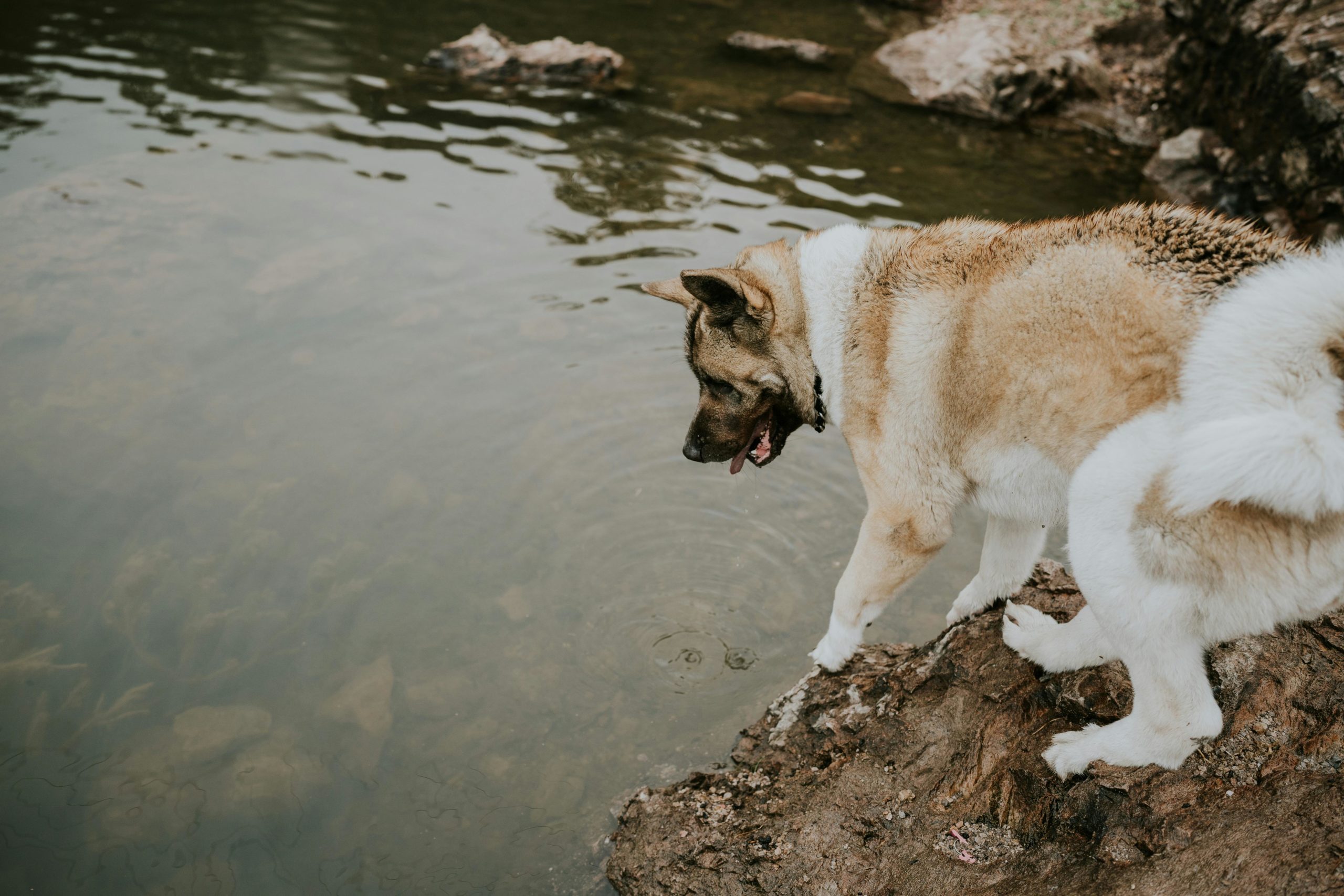
How is the Akita with children
A dog breed with impressive stature and a distinctive curly tail, the American Akita is known for its strong personality. When it comes to dealing with children, it is important to know that the American Akita requires a unique approach. Although they can be loving and protective, caution is needed, especially if the dog has not been raised with children from a young age.
These dogs reach considerable size and have a powerful, triangular-shaped body, making it essential that both the Akita and children learn how to interact safely.
It is important to monitor dog-child interactions, especially in the early stages. Training and socialisation play a crucial role; a well-socialised American Akita that has had positive experiences with children is likely to be better able to deal with them in a friendly and patient manner.
Parents should teach their children how to treat the dog respectfully. This means no rough play or challenging the dog, and recognising signals that the dog needs space. It is also advisable not to leave the Akita alone with young children.
Benefits of an American Akita
- Loyalty and Protection: The American Akita is known for its unconditional loyalty and protective behaviour towards its family, which makes them excellent guard dogs.
- Independence: This breed is independent and does well alone, making them suitable for households where people work during the day.
- Robust Health: In general, American Akitas are healthy dogs with a sturdy constitution.
- Beautiful Appearance: With their impressive stature and unique appearance, including a powerful build and curly tail, they are a standout.
- Intelligence: They are intelligent and can be trained well, provided the training is consistent and positive.
Disadvantages of an American Akita
- Training and Socialisation: They require intensive training and socialisation from an early age to avoid behavioural problems.
- Dominance: Their independent nature can sometimes come across as dominance, which can be a challenge for inexperienced owners.
- Dealing with Other Pets: They can be dominant towards other dogs and are not always suitable to live with other pets.
- Care: Their thick coat requires regular grooming, especially during moulting, to remove tangles and excess hair. 5. Space requirements: Because of their size, they need plenty of space, both indoors and outdoors.
How old an American Akita gets
The American Akita is known for its relatively long lifespan, especially considering its size as a larger dog breed. On average, American Akitas can reach an age of around 10 to 13 years.
However, this depends on several factors, including genetics, lifestyle, nutrition and the general healthcare they receive during their lives. As with all breeds, quality of care plays an important role in the life expectancy of an American Akita.
Price of an American Akita
The American Akita, also known as the Akita Inu, is priced between $1,500 and $3,000 for a puppy in the US. The cost varies based on several key factors:
- Breeder Reputation: Puppies from esteemed breeders known for champion bloodlines tend to be pricier.
- Pedigree: Purebred American Akitas with registration from the American Kennel Club (AKC) are more costly than those without.
- Location: Prices may be higher in areas with a higher living cost.
- Age: Puppies are generally more expensive than adult Akitas.
- Coat Type: The standard double coat variant may command a higher price over the less common short-haired type.
- Show Quality: Akitas bred for show or competition are typically more expensive.
Price Summary:
- Standard Range: $1,500 – $3,000
- Premium Range: $3,000 – $5,000 for show-quality puppies or those with unique colors
Budget-Friendly Option: Adoption
Adopting an American Akita from a shelter or rescue can be a more affordable choice, with lower fees and adult Akitas more readily available than puppies.
Breeds to Consider:
For fans of the Akita’s distinct traits, these breeds might also appeal:
- Shiba Inu: A smaller, playful alternative with a similar aesthetic. Prices range from $1,200 to $3,000.
- American Eskimo Dog: Known for its friendly disposition and dense white coat, with prices from $1,000 to $2,500.
- Chow Chow: Shares the Akita’s loyalty but in a smaller package with a distinctive tongue and mane. Typically priced between $1,200 and $2,000.
- Samoyed: A sociable breed with a fluffy white coat, smiling expression, and prices from $1,500 to $3,000.
Extra Advice:
- In-depth Research: Ensure the Akita’s strong-willed nature suits your lifestyle.
- Visit the Breeder: Assess the environment and the health of the puppy’s parents.
- Ownership Preparation: Account for ongoing costs including nutrition, healthcare, grooming, and training.
- Importance of Socialization: Given the Akita’s reserved nature with strangers, prioritize early socialization.
Remember: Opting for a dog breed involves a significant, long-term commitment. Selecting a breed that complements your lifestyle ensures a harmonious relationship and a nurturing home for the dog’s lifetime.
